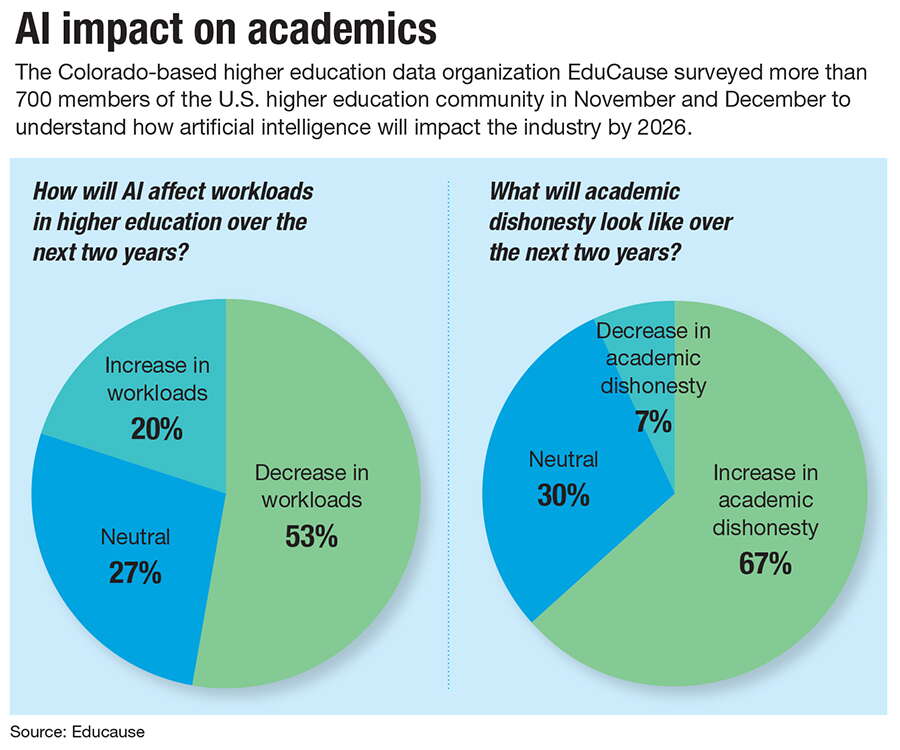
Training the workforce: Central Mass. universities are infusing AI into curricula, as they navigate the ethical and technical issues
 Photo | Matt Wright
Elke Rundensteiner has been one of the leaders at Worcester Polytechnic Institute who have implemented AI into the curriculum, which includes a master's degree program.
Photo | Matt Wright
Elke Rundensteiner has been one of the leaders at Worcester Polytechnic Institute who have implemented AI into the curriculum, which includes a master's degree program.
As artificial intelligence transforms the workforce, Central Massachusetts universities are implementing the technology into their courses, solidifying their policies to prevent plagiarism and trying to address concerns for faculty and students.
The growth of AI curriculum comes as the technology is being touted across the economy, creating the need for an AI-trained workforce coming out of schools. While 4% of companies in a November survey from the U.S. Census Bureau said they were using AI to produce goods and services, the rate of adoption is higher at companies with more than 5,000 employees, where 50% of businesses are using AI.
“Technology is changing so fast, and there are many cool things to learn,” said Elke Rundensteiner, head of data science and professor of computer science at Worcester Polytechnic Institute.
WPI created an artificial intelligence master’s degree last fall. The master program allows students to grow technical expertise in understanding and innovating AI systems. Around 30 students are enrolled in the program, while many undergraduate students have expressed interest in AI, Rundensteiner said.
With AI-related degrees becoming more common, these degrees will drive opportunity in Massachusetts, said Pat Larkin, director of the Innovation Institute at Massachusetts Technology Collaborative and a member of the state’s AI task force.

In February, Gov. Maura Healey signed an executive order establishing an AI Strategic Task Force to address the impact AI has had on businesses and higher education institutions.
The task force is focused on capturing the talent, whether its newly generated ideas or strategies leveraging AI from the state’s research institutions, to create a place of economic growth, Larkin said.
AI in the workforce
As schools adjust to the changing technology, the workforce is doing the same. The Innovation Institute at MassTech has funds supporting research, development, and technology to enhance the deployment of AI.
MassTech made a $550,000 investment in UMass Chan Medical School in Worcester to develop an AI assurance lab designed to evaluate processes and impacts of health AI technology.
The assurance lab “will establish standards that allow the healthcare industry to deploy the best in enabling caregivers to do what they do in a better and more profound way,” Larkin said.
Additionally, MassTech made an investment in Northeastern University in Boston to support small and midsize enterprises to develop AI strategies.
Having knowledge of AI will create a dual competency for any field, allowing people to be more successful, Larkin said.
AI has already changed the way people work, as technologists, scientists, and engineers use AI to advance their work and build technologies, Rundensteiner said.
“Their jobs are going to be exciting,” she said.
Changing how college students learn
In addition to new degrees, AI is transforming how colleges and universities are structuring their classes and how students are learning across all academic disciplines, Larkin said.
“AI is going to change the face of education, in terms of the impact it's going to have on research and discovery, on teaching pedagogy and individual support for students,” he said.
At WPI, while students are allowed to use the technology, Rundensteiner said all students are required to disclose where they got their information or how they completed their work to ensure students are not using AI unethically.
In order to prevent cheating with AI, professors have begun using AI detection tools such as GPTZero and TraceGPT. However, this software is far from foolproof, according to a report from MIT Sloan Teaching and Learning Technologies, which found high error rates could lead to instructors falsely accusing students of misconduct.
“There has been this pendulum swing of attempting to use traditional plagiarism detection tools, but they generally have not worked very well,” said John Magee, dean of the college and professor of computer science at Clark University.

Instead, Magee said professors are trying to adopt a curriculum to ensure students are still achieving learning outcomes, which may require a different approach to assignments.
“We might be thinking about changing how we're prompting students to write something that ensures they're having to incorporate their internal knowledge in a way that AI systems wouldn't be able to talk about,” he said.
Prior to AI, it was not easy to generate an essay, but now it can be completed in seconds by inputting a few words into ChatGPT, a popular chatbot launched in November 2022.
Clark is looking to use AI tools as a teaching partner, said Magee. Instead of asking ChatGPT for direct answers, students could ask the software to be an assistant, which will provide a guide to go through the problem-solving process.
“We can kind of augment the approach of trying to have students become problem solvers by helping them get unstuck with these tools,” he said.
AI in the classroom
AI has not only found its place among colleges and universities, it has found a home in K-12 classrooms as educators are faced with similar challenges.
Mary Marotta and Craig Sheil, adjunct professors at Fitchburg State University, are co-teaching a course in the fall for educators seeking professional development about AI and emerging technologies.
“The purpose is to make sure educators are becoming AI aware, highlighting the pitfalls and how it can support learning,” Sheil said.
Whether they are educating young or experienced teachers, the reaction is a mixed bag, as some are overwhelmed and others are excited to embrace the change, he said.
Both educators acknowledged the concerns teachers have but show how they can use the technology.
“When teachers see these examples, a light bulb goes off,” Marotta said.

The adjunct professors have used AI in classes to convert information into different modes, whether it be changing a presentation into a poem or a song. Sheil said every student processes information differently, so this technology can help them.
In addition, Marotta emphasized the importance of teaching students the capabilities of AI, such as when The Beatles used the technology to incorporate John Lennon’s voice into their new song, “Now and Then.”
“It is important to talk about current events and what is going on in the world,” Marotta said.
Leveraging technology
Whether using AI in the classroom or workforce, many still hesitate to use the technology, Larkin said. It is important to not be afraid of it and to embrace it.
The state understands the downsides of AI and the disruptions to the workforce, but is working to show how AI can leverage the capabilities of human activity, not displace it, Larkin said.
This cautious approach is not new, as people have always been hesitant when technology is introduced, Rundensteiner said.
As a computer scientist, Rundensteiner looks toward technology to form a higher efficient workforce, but acknowledges that change is scary. With its growing use and potential consequences, she said everyone needs to be educated on how to use AI properly.
“We need to learn that we cannot blindly trust the information, and we need to have better policies and also better education for everybody to understand when it can be safely used,” she said. “There is a lot of work to be done.”
For those hesitant, Magee suggests to open ChatGPT and test its capabilities, adding it is as easy as typing something into Google.
“Start exploring and see what it can do for you,” Magee said. “Try to figure out what its limitations are and that's how we are all going to learn how to use it better.”
The future of AI
When looking at education, Marotta said it is hard to imagine what the future could look like.
“We are seeing it emerge as we are moving forward,” Marotta said, adding teachers need to make sure students are still learning.
Similarly to the widespread use of the internet, AI has become accessible to everyone. Like any other technology, Magee said it is interesting to see what the lasting effects of AI will be, how it will change the demographics of work and how it can benefit society long term.
“It is a technology that is going to define the economy for generations to come,” Larkin said.
Sara Bedigian is a participant in the Editorial Internship Program at Worcester Business Journal. She is a rising junior at the University of Connecticut, where she studies journalism and political science. She will be the editor of the student-run newspaper The Daily Campus in the fall.













0 Comments